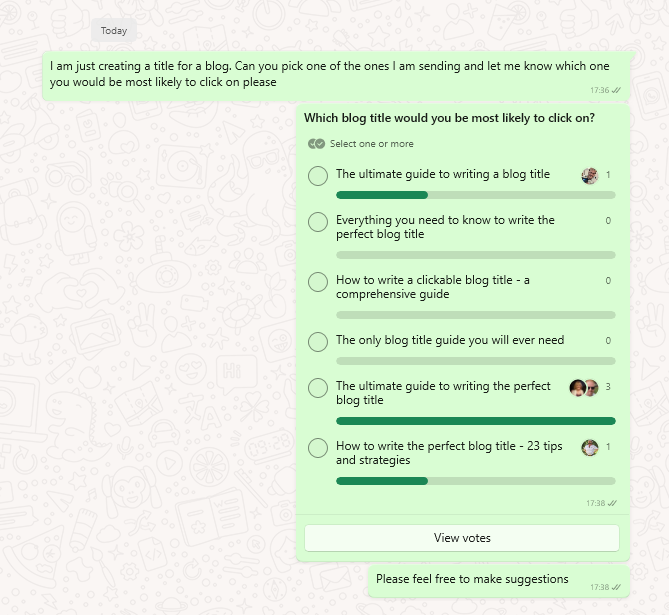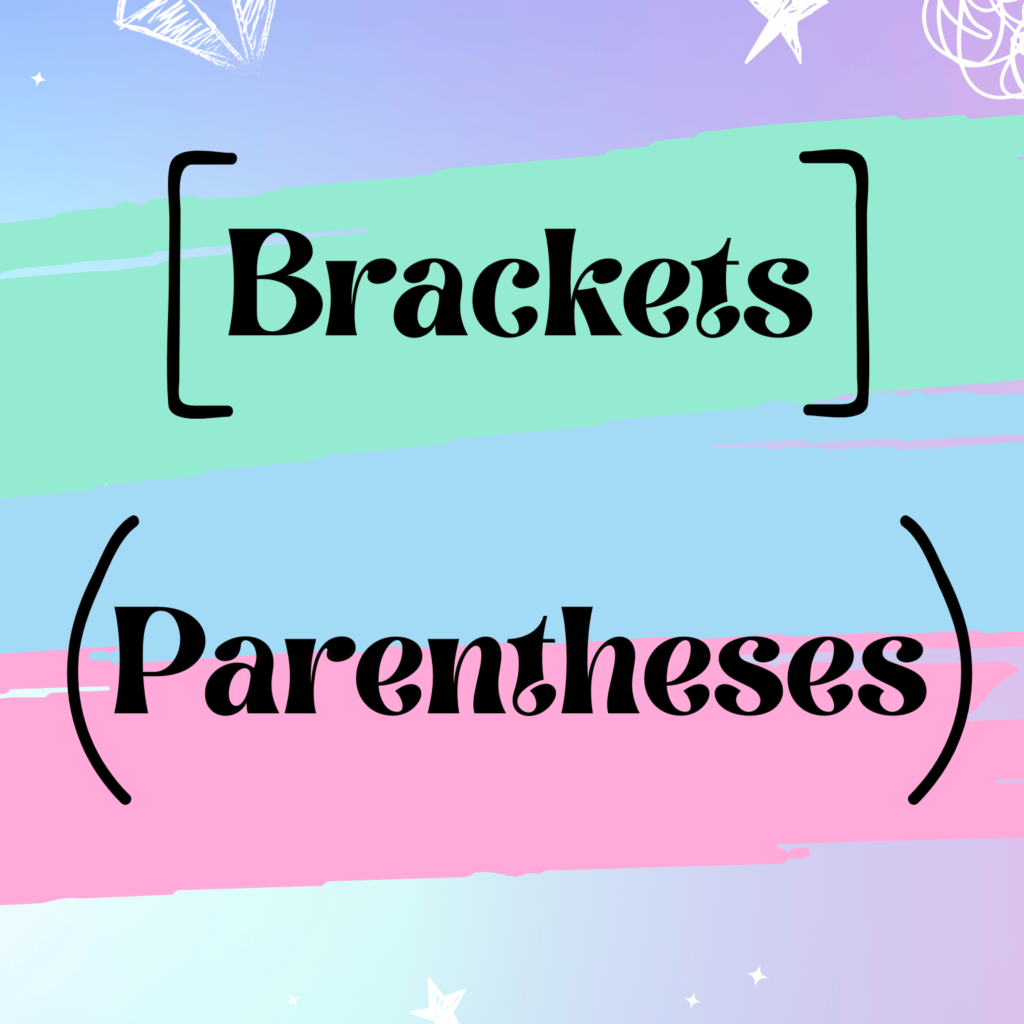Every day, 8.5 billion searches are made on Google – that’s a lot of competition. Your blog title tells Google which of these search queries your blog is answering.
Get this wrong and your blog could fall into the Bermuda Triangle of the content world never to be seen again.
How can you create the best blog title?

It is best to have a process and do some research when trying to create your perfect blog title – here are 6 things you can do:
1) Create a draft title
Start with a draft title.
It doesn’t need to be perfect. It needs to be clear.
You need to understand from the start what your audience will expect to read and make sure that is what you set out to write for them.
Imagine if I asked you to:
‘Write a blog about hamsters’
… and I didn’t narrow it down. You will find yourself jumping from topic to topic with no idea what specific question you are answering for your reader.
However, if I asked you to:
‘Write a blog about how to choose the right hamster breed for you and your young family’
A clear and specific blog title will help you write a concise blog.
2) Don’t stick with the first blog title you come up with
Grab a blank piece of paper.
Write out some significant words and phrases related to the topic. Include as many words as you can think of that are closely related to the topic.
You should aim to create 5 – 10 draft titles and then narrow them down and develop the best ones using the techniques in this guide.
3) Test your blog titles
Send a choice of 3 titles to your friends and family to see which one is most likely to result in clicks. Whatsapp polls work really well for this.

As a writer you need to be comfortable with feedback.
It can be hard to hear ‘I wouldn’t click on any of them’ but would you rather live in an echo chamber where people tell you what you want to hear?
No? Not healthy?
Make sure the people you ask feel able to be honest with you. But conversely don’t send it to negative a*seholes. Make sure you choose people who are really on your side.
4) Explore page one of Google
I am not advocating copying but you should have a look at Google and check out the top-performing blogs – success leaves clues.
There is a reason those articles are on page one of Google so don’t try to be too clever and stray too far from the beaten track. The most popular style of title on page one of Google is likely to be the best format to use i.e How to, Number titles. Listicles, Guides.
Do not reinvent the wheel but do develop it and give the reader a reason to choose your blog instead.
5) Use magazines for inspiration
Why do we buy magazines? Because the titles make us want to read more.
The titles have been carefully considered. Study them until you understand the patterns because success leaves clues.
This is a genius idea while you are honing your craft and learning how to write blog titles.
6) Use a headline analyser
Monster Insights, Co Schedule and Aisoeo all provide free headline analysers. They all do a similar thing. They provide a quick analysis.
They cover things like:
- Length – character, and words
- Sentiment – positive or negative
- Type of words used – emotional, power, common and uncommon
- Type – is it a ‘How to’, ‘List’, ‘Question’ title
Don’t aim for perfection, get the title in the green zone and you’re good to go!

Let’s explore the different structures and types of blog titles you could use:
1) How to?
People search online to learn something new or to have their questions answered. 72% of marketers agreed that the ‘how to’ title generates the most organic traffic.
Use your own examples of how you did something and how long it took. This promises your readers that they can achieve the same within the same timescale.
Example 1 – How to groom your dog at home like a professional
Example 2 – How we stopped our cat scratching the sofa in under 2 weeks
Tip – Add extra information at the end. For example:
Example 1 – How to do XYZ in 7 steps
Example 2 – How to do XYZ: A step-by-step guide’
Example 3 – How to do XYZ for beginners
2) Where? What? Why?
‘Where? What? Why?’ leans into the reader’s desire to learn something new.
Example – Where to find dog-friendly chocolate this Halloween
Example – What you can learn from Zak George about dog training
Example – Why you need a license to be a dog sitter
Tip – Consider titles with ‘here’s why’ because it positions you as knowing about a problem and having the solution.
Example 1 – Here’s why you should never give your cat animal bones
Example 2 – You should never give your cat animal bones: Here’s why.
3) Listicles and numbers
Listicles are blogs containing numbered tips, items, and points.
Adding ‘the’ in front of the number in your title gives your list more authority. This is THE list and not a random list.
Why do lists do so well?
The human brain craves organisation. A list tells your readers they will have quick, concise information and they will know what to expect.
It is also a blessing for the skimmers… of which I am one.
Example 1 – We found the 10 best cat toys after testing more than 100
Example 2 – The 7 best ways to help your cat to lose weight
Tip – Titles with numbers result in twice as many clicks; the number 7 outperforms the other numbers and odd numbers perform better than even numbers. No one knows why. Take that one up with the Google Gods.
4) Improve your X with X
This title promises your readers they can achieve something by doing something else.
Example – Improve your dog’s behaviour with the Pupford Dog Training App
Tip – You could replace the word ‘improve’ with other words such as ‘increase’ or ‘sell’.
5) Brackets and parentheses

Hubspot found that blog post titles ending with brackets or parentheses perform better than a lot of other blog title structures.
Example – 23 tips on how to write blog titles (without forgetting SEO)
Tip – OptinMonster found that titles with hyphens have a 9% higher click-through rate.
6) Guides
A Hubspot study found that blogs with the words ‘Guide’ or ‘How to’ in their title get the most organic traffic. Guides specifically get three times more organic traffic than other blog posts.
Guide’ lets your audience know that this blog is comprehensive, juicy and all-encompassing.
You are telling them their search ends here. They think they will get all of the knowledge they need and you need to make sure you deliver.
Make it more interesting. Is it a beginner’s guide, an ultimate guide, the only guide they will need, or a step-by-step guide?
Consider using ‘Everything you need to know about’… you could use both.
Example – The simple guide to rat care: Everything you need to know.
7) Data and statistics
Alex Turner from Buffer demonstrated the impact of adding data to your headline by testing these two versions of headlines for the same blog:
- The simple test that increased our referrals
- The simple test that increased our referrals by 30%
The data backed headline had 40% more clicks! Just make sure you use data from the original source, reference it (or use a link back to the source), and make sure it is accurate.
Tip – Using the current year in your title will be great if your reader wants the most up to date information.
Example 1 – Which dog breeds are facing the threat of extinction in 2024?
Example 2 – 90% of Dog Groomers say they can’t live without this tool
8) Questions
It is safe to say people are typing questions into Google endlessly.
Think about the questions your audience asks and if those questions are begging to be answered, they will probably be great candidates for blog titles.
You could ask a question followed by a statement or ask if one thing is better than another. Provocative questions will result in more clicks but avoid clickbait at all reputational costs.
Example – Why do single women prefer cats to dogs?
Tip – At the end of the blog you could close with a question to increase engagement.
9) X vs X
This is a very simple comparison headline and offers an obvious, clear and concise description to your readers so they know what to expect.
Example – Doggy Day Care VS Hiring a Pet Sitter: Make the right choice for your pet
10) The only…
Telling your reader this blog is the only thing they need tells them that you are providing a permanent solution to their problem and ending their search.
Example – The only blog title guide you will ever need (with examples)
11) Stop doing this…
This promises an improvement for your reader. It explains why what they are doing is wrong and leads them to a better alternative.
Example – Stop punishing your dog for being naughty: Do this instead
12) The simple…
No one wants to wade through treacle so the promise of reading something simple and easy to understand is bound to be alluring.
Example – The simple solution to stop your cat scratching your sofa

Here is some advice about the words you choose and how to use them in your blog titles:
1) Use words everyone can understand
Write a blog title using words that an 11-year-old could understand. Don’t sacrifice clarity by trying to be too clever.
People might be skimming over a few titles on Google and if they have to put in effort to work out what your blog is going to be about…
… Well, they just won’t. It is too competitive out there and ain’t nobody got time for that.
2) Unusual words
Use a spicy word!
If the topic allows, and using common sense, find some less common words to use in your blog title.
How about instead of unhappy you used the word miserable. It is more interesting but it does not detract from the meaning.
Example – ‘The complete 9-step guide to training your spirited puppy’
3) Power Words
Power Words are words used to trigger a psychological or emotional response from your reader. Words like:
- Bizarre
- Never
- Secret
- Obsessed
- Unexplained
- Dominate
- Unique
- Master
- Game-Changer
- Spotlight
- Bonus
- Last chance
- Hurry
- Vital
- Guaranteed
- Conquer
- Elite
- Insider
- Breakthrough
- Unleashed
- Instantly
- Premium
- Rare
- Offer
- Top
- Free
- Incredible
- Countdown
Squeeze one of these into your title, just don’t squeeze an unnatural amount in!
4) Keywords and SEO
Build the title around the keyword or key phrases you are trying to rank for. Google Keywords is a free Keyword search tool so you can find words that are less competitive and easier to rank for.
When positioning your keywords remember people read from left to right and skimmers will pay more attention to the first 3 words.
If you think they must see your keywords, consider putting them at the beginning.
Your title should sound natural, not awkwardly stuffed with keywords that don’t make sense. Write for humans first and Google second.
Google punishes sites for keyword stuffing so remember the user experience is equally important.
A trick is to use a colon to separate search-friendly words and emotive words or a question.
Example 1 – The 7 best cat wands: A quick way to save your sofa
Example 2 – Dogs in labour: Everything you need to know
Example 3 – Dogs in labour: When to call the vet?
5) Words that create an open loop
Creating a loop means using words to create a question for your reader; a question like ‘What is this secret?’
This generates a gap of information that compels people to want to learn more and, effectively, “close the loop.”
Use words like
- Hack
- Secrets
- Surprising
- Insider
- Ideas
- Powerful
- Strategies
These words increase the likelihood of someone reading your blog to answer the question your headline created in their mind.
Example – 7 well-kept horse riding secrets you wish you knew sooner
6) How many words should you use in your blog title?
Keeping your title length under 60 characters means Google won’t cut it off in the search results and it could have a higher click-through rate.
A Hubspot study found that blog titles with 7 or fewer words got 36% more organic traffic than posts with 14 or more words.
Remember to write for humans and focus more on using the right words than counting the words you use. Especially if your primary goal is for your blog to be shared on social media.
It is thought that people pay the most attention to the first 3 and the last 3 words in the blog post title but again, this does not mean you should be aiming for 6-word blog titles.
Bear this in mind if you use a longer title.
For Google, you should use important words both at the beginning and around the 45-60 character point, not at the end.

There are some psychological strategies that make it more likely someone will read your blog:
1) Urgency, scarcity, and FOMO (Fear of missing out)
No one wants to feel like they are missing out!
Be that on information, news, an event, or a new product that everyone is raving about.
Some examples of blog titles that create FOMO:
- Why XYZ keeps selling out (and where you can find it)
- What the experts won’t tell you about XYZ
- Why the pet show will only release 100 VIP tickets (and when)
These types of titles create a potential knowledge or experience gap between
- What we do and don’t know
- What we can and can’t access
- What we can and can’t buy
We perceive something is running out, limited, or a big secret we want it. Think about how you feel at a buffet with a huge queue.
2) Mistakes
Regret aversion is the anticipation of regret over making the wrong choice – no one wants to make a mistake and we will go to great lengths to avoid this.
Use your blog post title to explain how you or others made a mistake and how your audience can learn from this.
Example – 11 mistakes I made when buying my first pet snake (so you don’t have to)
3) Clickbait
Thou shalt not deceive.
Your reputation is everything in business so don’t mislead your visitors.
Say what you will answer or resolve then do it.
You can not afford to lose trust and have a high bounce rate (bounce means someone landed on your blog and immediately left and Google judges you on it).
Tip – If someone gets value from the blog they are reading, and they trust your content, they are more likely to read another blog you wrote. Make sure you have internally linked your blogs together to increase the amount of time your visitors stay on your page.
4) Leave them wanting more
Don’t drop all your candy in the foyer.
Be a temptress and create curiosity.
The reader needs enough information to know if the blog is relevant to them.
They also need enough information to tempt them to click and read more.
Example – 3 supplements every dog owner should know about
Example 2 – 5 common mistakes Dog Groomers are making (and how to avoid them)
BUT be aware… all rules are made to be broken!
6) Direct answers
Sometimes, if an answer is obvious and the search query requires a concise answer it is okay to provide a direct answer in the title.
Make sure you also add a reason for your reader to read the rest of the blog.
Example – You should clip your cat’s claws (Learn why here)
This example demonstrates how a question can lead to more questions but you need to lead your audience and let them know you can also answer those new questions.
5) Write your blog title for a specific audience
Unless your blog is genuinely for everyone, the target audience should be reflected in your title.
Don’t use this type of title if it is for something specific like a new grooming tool for dogs:
‘This invention will save you time and effort’
Two things will happen:
- It will have a high rate of people clicking and leaving straight away (known as a bounce rate) which is very bad news for your relationship with Google
- It won’t get seen by the target audience
Example of a better title – Why Dog Groomers need XYZ (and why it keeps selling out)

There you have it, loads of strategies for you to mix and match!
You can combine some of the strategies you have learned, you don’t need to stop at one. For example combining ‘The best’, ‘Guide’, and ‘Uncommon words’ could land you a title like this:
Example – ‘The best pet travel guide: Plan an epic voyage with your dog’
Be careful not to get too caught up in the rules, if you try to obey every title rule you may end up with an uninspiring, confusing title, and an increased reliance on coffee and wine.
And one important thing to remember….
You can always change the blog title if it is not working for you because invisible ink never dries!
If you immerse yourself in learning and practicing the techniques I have shared with you, it won’t be long until these blog title structures flow seamlessly out of your mouth.
But for now, get the Post-it notes out of the drawers and stick these tips on the wall.
This is just one of the many aspects to consider when writing blogs. If you want to hire a professional pet blog writer send me a message and let’s discuss how I can take all the complications of writing the perfect blog and blog title off your hands.




